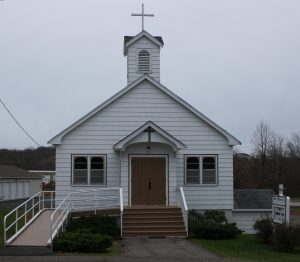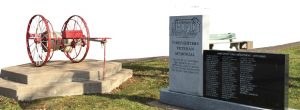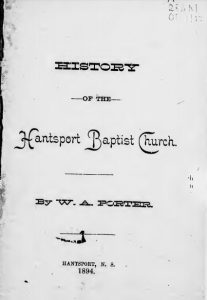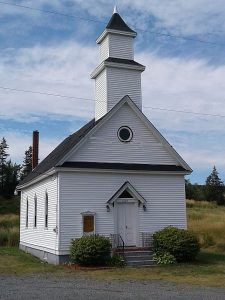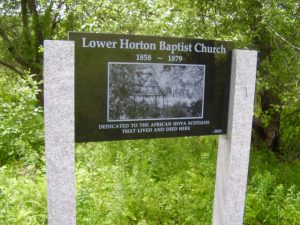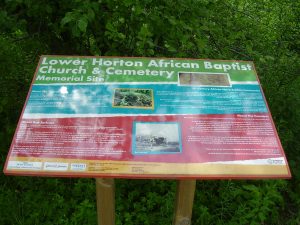- St. Mary’s Roman Catholic Church
- St. Andrew’s Anglican Church
- Avon United Church, formerly St. James; originally Trinity Methodist Church
- Presbyterian Church
- Hantsport Baptist Church
- Bishopville Baptist Church
- Lockhartville Baptist Church
- Lockhartville Methodist Church
- Lower Horton “African” Baptist Church
- Mount Denson Baptist Church
- Mount Denson United Church
- St. Joseph’s Roman Catholic Chapel
- West Brooklyn Baptist Church
St. Mary’s Roman Catholic Church
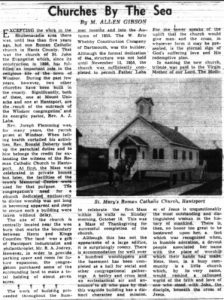 “Churches By The Sea” by M. Allen Gibson
“Churches By The Sea” by M. Allen Gibson
Published 27 Jun 1959 – The Chronicle Herald
Excepting the work in the Shubenacadie area there was, until less than five years ago, but one Roman Catholic church in Hants County. That was the church of St. John the Evangelist which, since its construction in 1898, has fulfilled an important role in the religious life of the town of Windsor. During the past few years, however, two other churches have been built in the county. Significantly, both of these, one at Mount Uniacke and one at Hantsport, are the result of the outreach of the Windsor congregation and its energetic pastor, Rev. A. J. Laba.
Rev. Joseph Flemming was, for many years, the parish priest at Windsor. When failing health curtailed his activities, Rev. Ronald Doherty took up the parochial duties and to him belongs the credit for extending the witness of the Roman Catholic Church to Hantsport. At first, the Mass was celebrated in private homes but later, the facilities of the town’s Memorial Centre were used for that purpose. The congregation’s need for a church dedicated exclusively to divine worship was not long in becoming apparent and steps to secure such a building were taken without delay.
The site of the church is centrally located near the wee burn that marks the boundary between Hants and Kings Counties. The land was a gift of Hantsport industrialist and philanthropist, Mr. R. A. Jodrey. However, in order to provide parking space and room for future expansion the congregation purchased some of the surrounding land to make a total holding of about seven acres.
The work of building proceeded throughout the Summer months and into the Autumn of 1955. The W. Eric Whebby Construction Company of Dartmouth, was the builder. Although the formal dedication of the structure was not held until November 13, 1955, the church was sufficiently completed to permit Father Laba to celebrate the first Mass within its walls on Sunday morning, October 16. This was a Mass of Thanksgiving for successful completion of the church.
Although this has not the appearance of a large edifice, it is surprisingly roomy. There is accomodation for well over a hundred worshippers and the basement has been completed as a hall for social and other congregational gatherings. A belfry and cross lend an ecclesiastical air and announce to all who pass by that this wayside building has a distinct character and mission. For the tower speaks of the uplift that the church would give men and the cross, in whatever form it may be presented, is the eternal sign of God’s suffering love and His redemptive plan.
In naming the new church, tribute was paid to the Virgin Mother of our Lord. The Mother of Jesus is unquestionably the most outstanding and distinguished woman in the history of mankind. There is, then, no honour too great to be bestowed upon her, a fact which was recognized when, in humble adoration, a devout people associated her name with the place of worship which their hands had made. Here then, in a busy community is a little church which, by its very name, would remind a calloused world of the faith and love of one who stood with John, the disciple, beneath the cross of Jesus.
 |
St. Andrew’s Anglican Church
“Churches By The Sea” by M. Allen Gibson
Published 19 Aug 1967 – The Chronicle Herald
November 27, 1890, was a memorable day for the Anglicans of Hantsport. Theirs was then the smallest religious body in the Avon-side town, but that fact had not discouraged them from building the church which, on that far-off autumn day, was formally opened for worship.
The date was shared with a meeting of the Avon Deanery, consequently, an unusual number of churchmen were present to take part in the first services in the Anglican church in Hantsport and to contribute to the colour and inspiration of the occasion.
From the beginning of their story, Anglicans living in Hantsport were served from Falmouth and Windsor. Until it was moved to Halifax in 1923, Kingès College was situated at Windsor. Frequently, divinity students from the college led the services of the Hantsport congregation.
A glance at the parish records reveals the names of many students who, subsequently, rose to positions of prominence. Archbishop John MacKenley, Canon C. W. Vernon and Rev. L. J. Donaldson are but a few of those whose lives of service in the Diocese of Nova Scotia included a ministry in Hantsport during the early years.
Hantsport was within the parish of Falmouth when, in 1890, the church, which bears the name of St. Andrew, was opened. Rev. C. H. Fullerton was the rector at that time.
The land on which the building stands was purchased from Mrs. Theodore Davison.
Among those who worked diligently towards the establishment of the church were Miss Ella Smith and Mrs. Lydia Fish, the former being the first organist.
Two years after the completion of the church, on November 14, 1892, the first confirmation was held with Right Rev. Frederick Courtney, the fifth Bishop of Nova Scotia, officiating.
Mr. and Mrs. Otis Smith were the first couple to be married in the church.
A bell was placed in the steeple in June, 1896. It was dedicated by the rector, Rev. George Howcroft, assisted by C. R. Cumming, who then was serving Hantsport as a lay reader.
Many gifts have brought beauty and usefulness to this place of worship, one of them being the litany desk which was made and presented by Thomas Morgan.
An important change in the structure of the church was made in 1939 when the basement was rebuilt to provide a practical and up-to-date hall.
On January 1, 1949, Hantsport was made a separate parish by the archbishop, Most Rev. G. F. Kingston. The first rector of the newly erected charge was Rev. L. Weldon Mosher.
The first ordination to be held in the parish was that of Rev. Gordon E. Pyke, who came to St. Andrew’s, Hantsport, as a deacon and, on July 25, 1959, was ordained priest.
In the heart of a busy community and situated by a principal thoroughfare, the church of St. Andrew presents an attractive and inviting appearance. Within there is quietness and peace, the colour subdued by the amber glass of the chancel window, a place of worship rich with blessing.
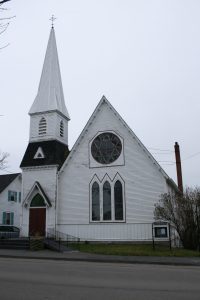 |
 |
 |
Avon United Church (formerly St. James United; originally Trinity Methodist Church)
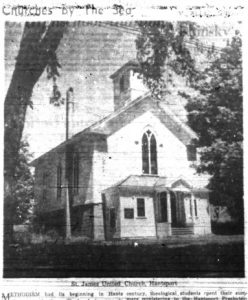
“Churches By The Sea” by M. Allen Gibson
Published 2 Mar 1957 – The Chronicle Herald
Methodism had its beginnings in Hants County with the arrival of immigrants from Yorkshire in 1773. These early comers settled in the vicinity of Newport. Among them was one John Smith, who, in the homes of the settlers conducted the first Methodist services in that part of Nova Scotia.
The work grew and Methodism spread into adjacent communities. The years between 1839 and 1843 saw extensive revivals which so strengthened the cause in Hants and Kings counties that new circuits had to be organized. The circuit that included Hantsport was organized in 1839 and, for a time, received the pastoral oversight of the second man at Windsor. Indeed, Falmouth and Hantsport continued to be supplied from Windsor until 1864 when Falmouth appears in the records as head of a circuit over which Rev. Andrew Gray was the pastor. This circuit name was changed to Hantsport in 1873.
It was during the ministry of Rev. Andrew Gray that the Methodist church was dedicated in Hantsport. That was in August 1865 and the name Trinity Wesleyan Church was adopted.
The Presbyterian cause in Hantsport was never very large. The first Presbyterian minister to visit and hold services in the town appears to have been Rev. John Logan Murdock who served with distinction during his forty year pastorate in Windsor. Following his retirement in 1870 he continued to live in Windsor until his death eight years later. He was laid to rest in the cemetery at Windsor where a handsome obelisk commemorates his life and work.
During the latter part of the nineteenth century, theological students spent their summers ministering to the Hantsport Presbyterians who were members of the Windsor church. Then, just before the turn of the century, the work was strengthened by the coming of several new families to the town.
In 1899, a Presbyterian congregation was organized in Hantsport and in 1900 a church was built under the leadership of Rev. Henry Dickie, the Presbyterian minister at Windsor. In 1911, Rev. A. B. Dickie settled in Hantsport and continued as pastor there until 1925.
On the tenth day of June, 1925, the two congregations in Hantsport became one. The same thing was happening all across Canada. For several years a movement toward a united Canadian Church had been irresistibly gaining impetus. The consummation of the movement was attained in 1925 when Canada’s Methodists, Congregationalists, and a large segment of the Presbyterians entered into the fellowship of the United Church of Canada.
Since 1925, Hantsport’s united congregation has been worshipping in the former Methodist church. The Presbyterian church was disposed of and converted for other purposes. At the annual meeting in 1942, the congregation chose the name of St. James.
Today’s minister of St. James’ Church also cares for the churches at Mount Denson and Falmouth. Sunday after Sunday he journeys from one community to another as did the pioneer ministers who preceded him. There is much that has changed in this busy industrial and agricultural area. But there is also much that is the same. To him, as to the first ministers, the errand and the message are as unchanged as the gentle hills which dip down to the tides and currents of the Avon.
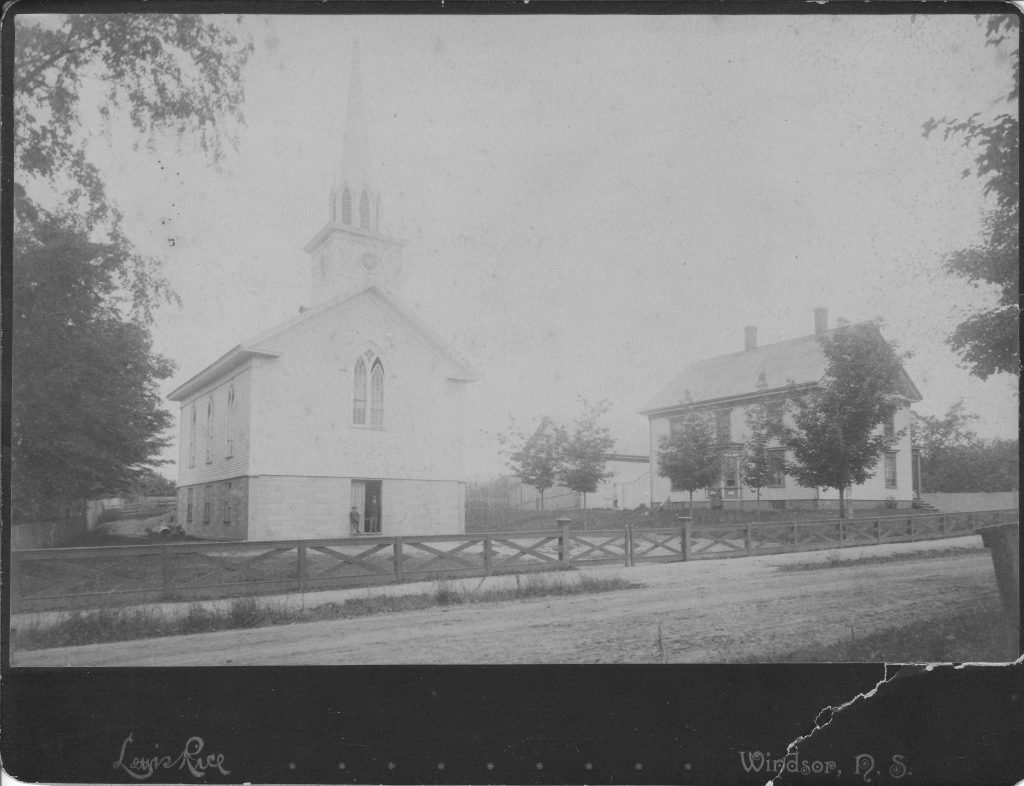
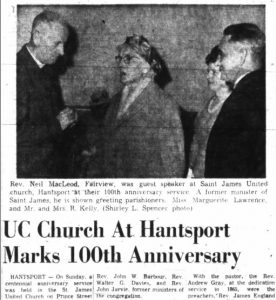
UC Church At Hantsport Marks 100th Anniversary
published 30 Sep 1965 – The Chronicle Herald
HANTSPORT – On Sunday, a centennial anniversary service was held in the St. James United Church on Prince Street here.
The speaker was the Rev. Neil A. MacLeod, Fairview, former pastor of the congregation. Rev. H. H. Blanchard, Hantsport, also took part in the service.
At the reception which followed in the church hall greetings were brought by Rev. F. H. Godfrey, Rector of St. Andrew’s Anglican Church. R. J. McGrath, representing St. Mary’s Roman Catholic Church, brought personal greetings from Rev. Father Joseph E. Mills, who was unable to be present. G. MacDonald and C. R. Manning brought greetings from the Mount Denson and Falmouth churches, which are a part of the Hantsport charge.
Letters of greetings were read from Rev. Gordon Gower of the Hantsport Baptist Church and from Rev. Thomas W. Hodgson, Rev. John W. Barbour, Rev. Walter G. Davies, and Rev. John Jarvie, former ministers of the congregation.
Refreshments were served by the United Church Women, with the assistance of the CGIT girls, who were dressed in authentic costumes of 100 years ago. The birthday cake was cut by Mrs. Annie Black and pouring were Mrs. Fred Guy and Mrs. Ted Johnston.
It is unfortunate that the historical records of the congregation of St. James United Church are so limited. It is known that the building was erected in 1865, M. Elder being the builder, while James Elder was the architect.
The village at that time already becoming famous as a shipbuilding centre, was known as “Half-Way River.” Renamed Hantsport in 1895, it is now an incorporated town, and through still rather small in area, has become very big in an industrial sense; well earning the title, “town of industries”.
The St. James United Church known then as the Methodist church was dedicated in August 1865. Half-Way River was at that time a preaching appointment of the ‘Falmouth circuit,’ as the Methodist parishes were called; but became the head of the ‘circuit’ in 1873.
With the pastor, the Rev. Andrew Gray, at the dedication service in 1865, were the preachers, Rev. James England and the Rev. Edmund Botterell.
A picture of Andrew Gray was presented to the congregation some years ago, and now adorns one of the modern new classrooms that form a part of the much-needed extension to the building; which was dedicated for Christian education purposes on October 25, 1964.
The founder of Hantsport, Edward Barker, was a staunch supporter of the Methodist church and five generations of his descendants have been loyal worshippers in the century-old building, which has become a familiar landmark in the town.
The union of the congregation of the Methodist Church and that of the Presbyterian Church – the corner stone of which was laid in 1897 – took place on June 10, 1925, to form the present congregation of the St. James United Church.
St. James has fine senior and junior choirs, who under the leadership of W. F. Mulhall and Mrs. G. H. Nichols, carry on the tradition set by the former Methodist and Presbyterian churches.
Presbyterian Church
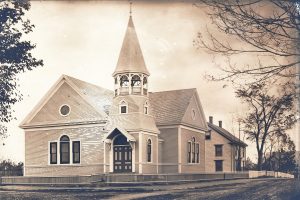 |
|
Hantsport Baptist Church
“Churches By The Sea” by M. Allen Gibson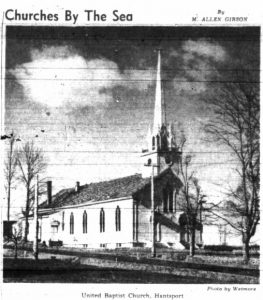
Published 25 Apr 1955 – The Chronicle Herald
Almost hidden by spreading trees, the Baptist Church is one of the first buildings to greet the traveller entering Hantsport from the East. The location is one of spaciousness and the church is saved from being just another place of worship by the delicate beauty of the steeple. When John Borden and Asa Davison raised the steeple, they vested it with the touch of the true artist. Refinement of scale and almost perfect symmetry characterizes this steeple as it rises above the tree tops ad the town.
The Baptists have held services in the district since 1811. Their first public worship was in a hall on Holme’s Hill. On January 13, 1830 the church was formally organized in the Union Meeting House at Mt. Denson which was then a part of Falmouth. The record states that eighteen members of the Baptist Church at Windsor obtained letters of dismission from that Church for the purposes of forming a separate Church to be known as the Particular Church of Falmouth.
The use of the title “Particular” in the name of the Church signifies that theirs was a Calvinistic theology and suggests an issue that is well nigh forgotten today. The other important division of the Baptists took its name from Jacobus Arminius. The Arminian or General Baptists placed their chief emphasis upon man’s freedom of choice as opposed to the predestination of the Calvinists. The two streams were united in the Maritime Provinces in 1905 when Free and Regular Baptists merged into the Maritime United Baptist Convention. The union is remembered in the official name of the Convention as well as in the names of such individual churches as that at Hantsport.
Rev. Robert Dickie was the first pastor of the newly organized church. He was succeeded by John Cogswell and he, by Ezra Churchill. Mr. Churchill, who later became Senator Churchill, was licensed to preach “within the limits of the Church only”. The membership increased rapidly and churches were built at Brooklyn and Hantsport.
In 1861, when the membership had reached 251, the name of the church was changed to “Hantsport Baptist Church”. That was the year in which Rev. William Burton began the first of two pastorates here. He was a native of Margaree who, despite educational limitations, was recognized by his contemporaries as “one of our best preachers, clear, forcible, and imaginative.” Graven on his tombstone is the fact that he preached 8,320 sermons.
The church has been blessed with faithful and energetic pastors. Rev. J. C. Bleakney came in 1875 and led in the construction of a vestry. During his ministry, 150 were added to the membership and 102 dismissed to form the Brooklyn Church. Rev. John McLean served the church for three years until his untimely death in 1887. He was a victim of the Black Fish Fever which scourged the village and which he contracted during his faithful visitation of the afflicted.
The choir loft and the steeple are two parts of the church that remain as they were originally constructed. The timbers of the original church were brought by sailing ship from New Hampshire. So the steeple, as well as being an invitation to worship, is also a reminder of the days when this modern “town of industries” was the home of men who “went down to the sea in ships”.
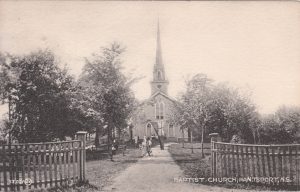
|
|
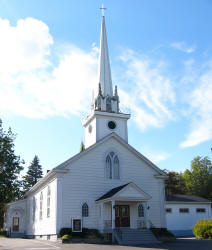 |
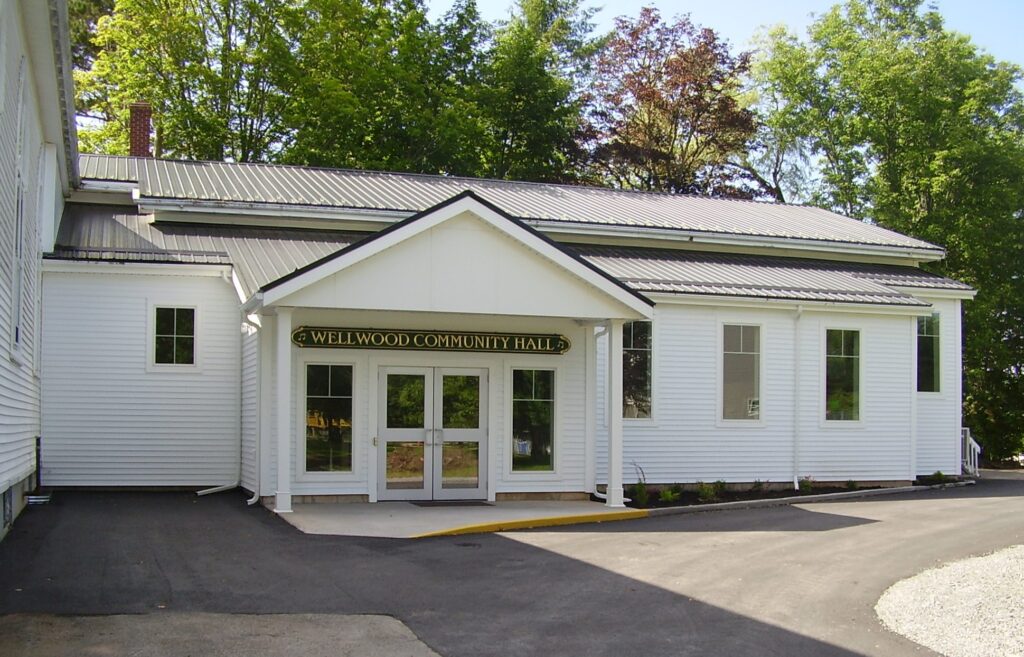
Dedicated 15 August 2021
Bishopville Baptist Church
“Churches By The Sea” by M. Allen Gibson
Published 18 Dec 1965 – The Chronicle Herald
The Halfway River plays a game of hide-and-go-seek with the border between Kings and Hants counties. It is not one of the province’s great waterways, but to those who follow its course it leads to grassy intervales and peaceful glades where hardwoods arch the stream and trout rest in the shady pools.
In the heart of the vale is Bishopville, a little settlement where, over 60 years ago, the Baptists built a church by the wayside.
On January 4, 1903, the place of worship, described at the time as ‘‘a credit to all who aided in its construction,” was dedicated. The occasion was marked by special services held in the morning, afternoon and evening of that far-off Sabbath day.
The pastor at that time was Ritchie Elliott, a native of Paradise, Annapolis County, and a senior at Acadia University. Following his graduation he served as a minister in New Brunswick and Nova Scotia until his death at Lawrencetown in 1923.
Speaking at the opening of the new church, Mr. Elliott “expressed his pleasure that success had crowned the efforts of the Bishopville people in erecting the pleasant church in which they worshipped.”
The dedicatory sermon was preached by Dr. E. M. Kierstead, professor of English literature and moral philosophy at Acadia. He was one of the many in the university’s history, both from the student body and the faculty, whose interest extended beyond the campus and into the neighborhood.
Another of the speakers that day was Rev. G. R. White, pastor of the Baptist church in nearby Hantsport.
In the evening of the Sunday of the church’s opening, the meeting was led by Rev. H. T. DeWolfe, then the principal of Acadia Seminary.
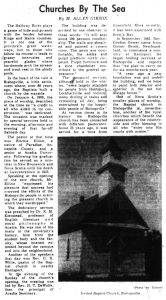
The building was described by one observer in these words: ‘It will seat some 100 persons comfortably. The walls are sheathed and painted a cream color. The pews are comfortable, the aisles and pulpit platform nicely carpeted. Pulpit furniture and a nice chandelier’ contribute to the general appearance.”
The inaugural services, although held in the winter, ‘‘were largely attended by people from Hantsport, Lockhartville and vicinity, many driving in teams and remaining all day, being entertained by the hospitable people of Bishopville.”
At various times in its history the Bishopville church has been connected with different pastorates. Some 25 years ago, it was served for a time from Greenfield. More recently, it has been associated with Scott’s Bay.
In September, 1963, Rev. Gordon Gower came from Corner Brook, Newfoundland, to commence a ministry at Hantsport. He began holding services at Bishopville and reports that ‘‘we plan to carry on for six months each year.”
“A year ago a new foundation was put under the building, and we hope to paint both interior and
exterior in the not too distant future.”
One of Nova Scotia’s smaller places of worship, the Baptist church in Bishopville is, nevertheless, another of the rural churches which benefit the appearance of the countryside and offer blessing to all who “enter into His courts with praise.’’
Lockhartville Baptist Church
“Churches By The Sea” by M. Allen Gibson
Published 30 Aug 1969 – The Chronicle Herald
As long ago as 1840, perhaps even earlier, meetings were held in the schoolhouse at Brooklyn through the outreach of the Baptist Church at Falmouth. So it was that the Baptist Church at Lockhartville had its beginning, for the community then known as Brooklyn was later called Stony Hill and, more recently, Lockhartville.
The congregation soon realized the desirability of having a meeting house and so, in 1842, erected the church which, with some changes, continues to serve to this day. In that year, also, Levi Lockhart, Joseph Brown and Frederick Nusin were appointed deacons of the fellowship.
Although they had a church of their own, the Baptists of Brooklyn, like their brethren in Hantsport, continued to be members of the Falmouth Church. A separate body was not organized until June 22, 1876, when the Central Baptist Association met with the congregation and instituted the Brooklyn Baptist Church which then had 102 members.
The first recorded baptism was solemnized in January, 1890, when Mrs Adolphus West and Mrs. Charles Harvey received that ordinance of the church. The baptistry was a brook that ran near the meeting house and the ice had to be cut away to make the water accessible.
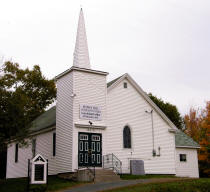
One of the earliest renovations made on the church was in 1890 when, according to the minutes, “It was moved and passed that the panels of the middle row of pews be taken out and that the inside of the building be ceiled.” Lic. Frank A. Starratt, whose ministry was characterized by successful revivals, was then the pastor.
Further structural improvements were made in 1913 during the pastorate of Rev. G. D. Hudson. The present steeple is not the original but was added a few years ago, its predecessor having been removed some years before.
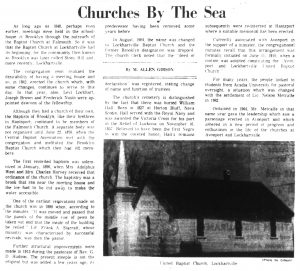
In August, 1904, the name was changed to Lockhartville Baptist Church and the former Brooklyn designation was dropped. The church clerk noted that the “deed of declaration” was registered, stating change of name and function of trustees.
The church’s cemetery is distinguished by the fact that there was buried William Hall. Born in 1827 at Horton Bluff, Nova Scotia, Hall served with the Royal Navy and was awarded the Victoria Cross for his part in the Relief of Lucknow on November 16, 1857. Believed to have been the first Negro to win the coveted honor, Hall’s remains subsequently were reinterred at Hantsport where a suitable memorial has been erected.
Currently associated with Avonport in the support of a minister, the congregational minutes recall that this arrangement was formally initiated on June 11, 1910, when a motion was adopted constituting the Avonport and Lockhartville United Baptist Church.
For many years, the people looked to students from Acadia University for pastoral oversight, a situation which was changed with the settlement of Lic. Nelson Metcalfe in 1962.
Ordained in 1964, Mr. Metcalfe in that same year gave the leadership which saw a parsonage erected in Avonport and which ushered in a new period of progress and enthusiasm in the life of the churches at Avonport and Lockhartville.
Lockhartville Methodist Church
LOCKHARTVILLE, a post settlement in Kings Co., N.S., on the Avon River, 3 miles from Hantsport, on the Dominion Atlantic Ry., Windsor and Annapolis branch. It contains 2 churches (Methodist and Baptist), and 1 school and 1 store. Pop., 200. — Lovell’s Gazetteer of the Dominion of Canada (1908)
An early name for this area was Horton Bluff and the Indian name for that area was Maktomkus, meaning “the black reek” or “the black rocks.” About 1848 the name Lockhartville first appeared commemorating early settlers. A Methodist Church was built before 1855.
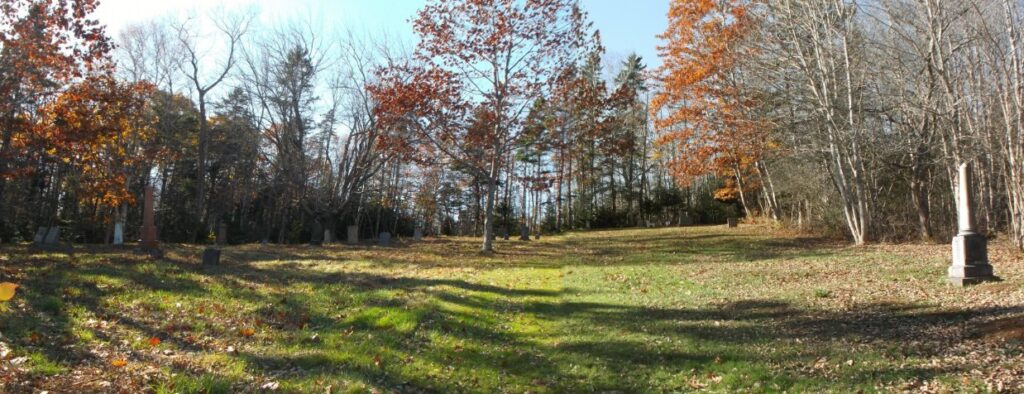
Lower Horton “African” Baptist Church
Mount Denson Baptist Church
“Churches By The Sea” by M. Allen Gibson
Published 23 Dec 1966 – The Chronicle Herald
Daniel E. Hatt still was an undergraduate student at Acadia University when, in 1895, he commenced a three year pastorate at Hantsport.
Many members of his congregation, he found, lived at Mt. Denson where a Baptist work had existed
from as early as January 13, 1830, when, in the old union meeting house located on the site of the present Mt. Denson cemetery, there was organized the body now known as the Hantsport United Baptist Church.
Mr. Hatt also found that the people of Mt. Denson were anxious to have their own place of worship. Indeed, they had, on November 11, 1892, inaugurated a building fund.
On September 16, 1896, the completed building was dedicated. It had cost about $900 and, at the time of the opening, a debt of only $50 remained.
A contemporary newspaper described the afternoon and evening services of dedication as being well attended, ‘‘large numbers coming from the neighboring towns and villages.”
The first couple to be married in the new church was Mr. and Mrs. Ensley MacDonald.
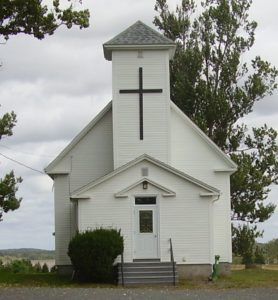
Mr. Hatt remained with the congregation for a year after his graduation and then moved to the United States for further study. Some years later, he became superintendent of Baptist missions in British Columbia.
It also is worthy of note that he was a poet of some ability whose publications included at least four volumes of verse.
For over half a century, the Baptists at Mt. Denson, although maintaining their own building, continued to be members of the Hantsport church. Finally, however, it was noted that “the work of the church has evolved to the point that in the interest of efficiency and to meet the new challenges of the day the members are organizing themselves into an autonomous church.’’
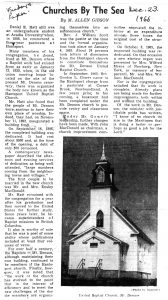
Rev. J. William Scott was the pastor at the time and the formal organization took place on January 4, 1953. About 24 persons took letters of dismission from the Hantsport church to constitute themselves the Mt. Denson United Baptist Church.
In September, 1963, Rev. Gordon L. Gower came to the Hantsport charge from a pastorate at Corner Brook, Newfoundland. A few years prior to his coming, a basement had been completed under the Mt. Denson church to provide vestry and classroom space.
Under Mr. Gower’s leadership, further changes have been made. With John MacDonald as chairman, a church improvement committee renovated the interior at an expenditure almost three times the
original cost of the structure.
On October 3, 1965, the improved building was rededicated. On that occasion a new electric organ was presented by Mrs. Wilfred Myers of Newburg, New York, in memory of her parents, Mr. and Mrs. William MacDonald.
Nor is the congregation satisfied that its work is complete. Already plans are being made for further improvements both within and without the building.
Of the work in Mt. Denson, the minister with justifiable pride has written, “I know of no church its size in the Maritimes that is doing a better or perhaps as good a job for the Lord.”
Mount Denson United Church
The first Methodist church was over in the corner of the present graveyard, next to Mr. Crossleys fence and near the road. It was a plain wood building 25 x 30 in size. It had no spire and the windows were the ordinary square windows. It was very rough inside with board seats and very high pulpit, common in those days.
In 1874 or 1875 there arose a dispute between Mr. Coffil and Mr. Johnson, two leading men in the church. Consequently Mr. Coffil left the Methodist church. He turned free Baptist and built a church for himself. This church was run for a year during which a revival was held. After this the church was closed for a time.
In 1878 the Methodist thought their church was too small and as Mr. Coffil had by this time become better natured they made him an offer for the church he had built. Some did not want to do this, but it was finally decided that it would be more convenient to buy from Mr. Coffil if he would sell. He said he would sell for $600.00 so they bought and deeded it over to the conference.
This church they bought is the present Methodist church. It had the high pulpit and closed pews common at that time. Since then the pulpit has been lowered and the doors have been taken off the pews. – History of Mount Denson
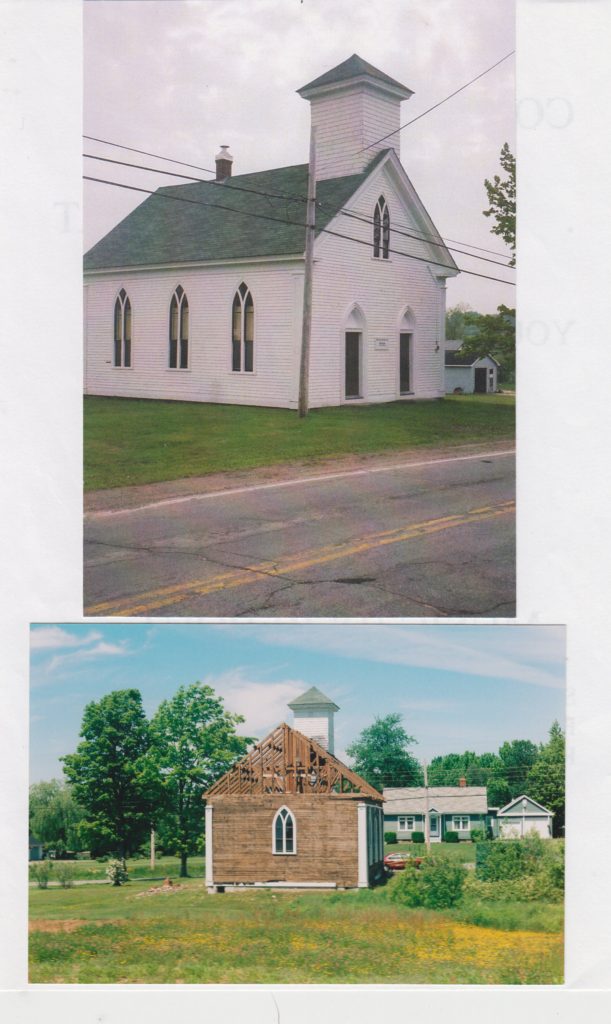
St. Joseph’s Chapel, Glooscap First Nation
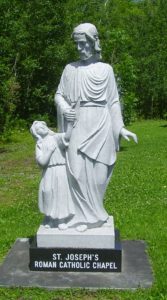 |
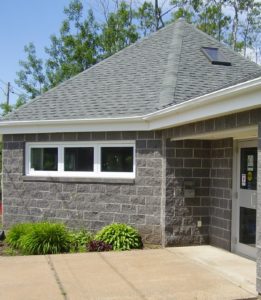 |
West Brooklyn Baptist Church
West Brooklyn Church built by Bro. Alfred MacIntosh who had labored among these people five years. Dedicated June 5th 1921. Dedication sermon preached by Rev. E.S. Mason Superintendent – Home Mission, Matt/21 13, “My house shall be called the house of prayer”. Offering fifty dollars, seating capacity about one hundred and fifty. Eighteen Autos and thirty – seven carriages were on the grounds, which consists of half acre. About three hundred in attendance. A beautiful fine day. This church is about four miles east of Morine Mountain.
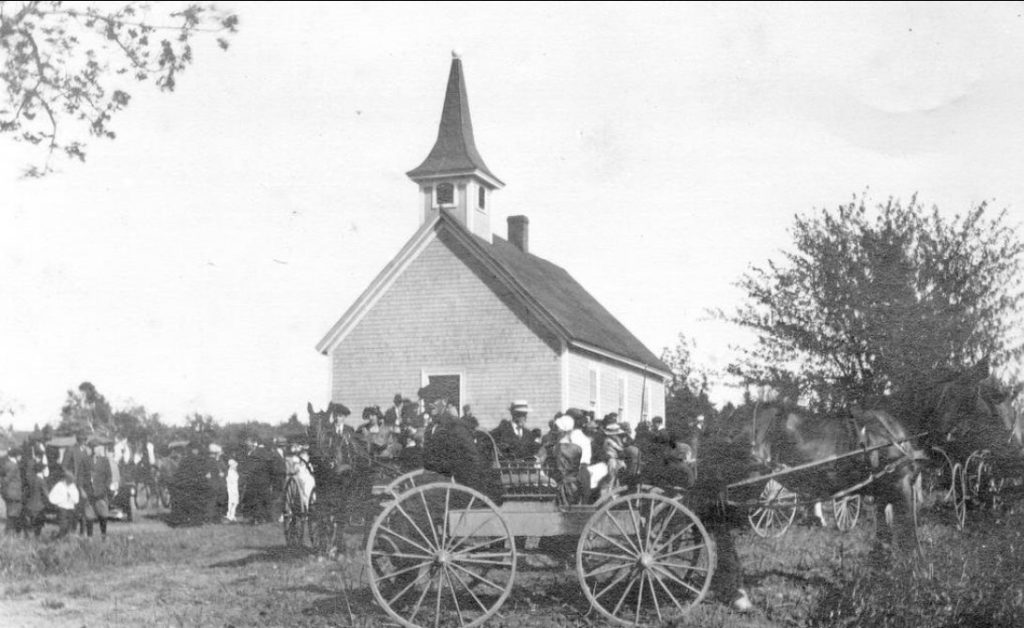
 |
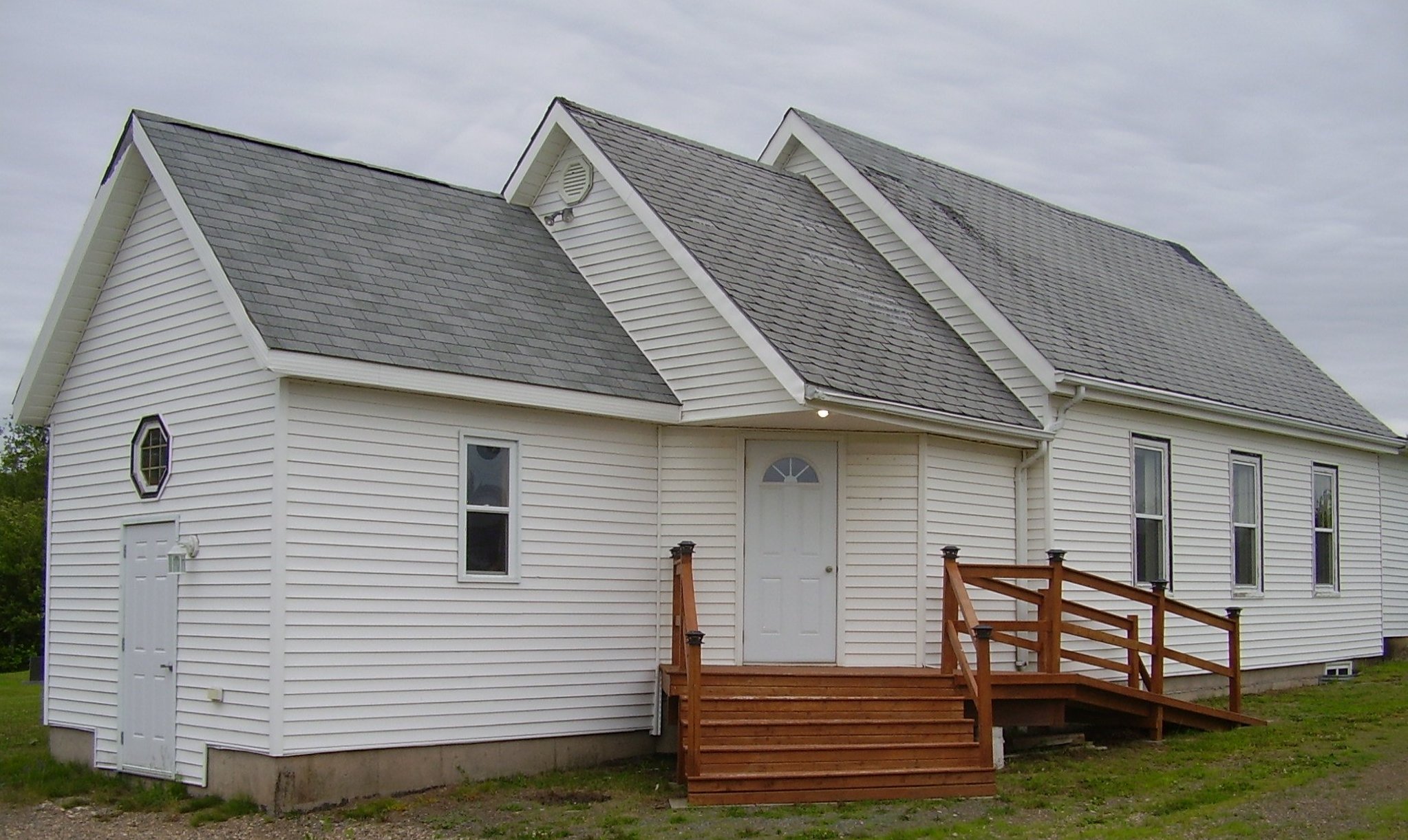 |

